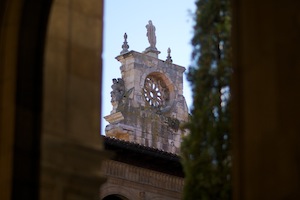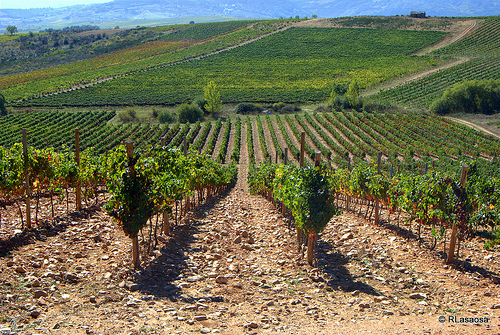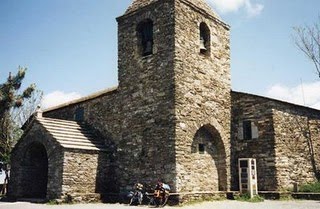
4th Stage Camino Frances: Leon – Sarria
The challenging part of the Camino. Start in the ancient capital of the kingdom of Leon and experience the changing landscape. After the last steps on the Meseta you will have to climb a mountain to get to Galicia and to travel in time.
Day 1

León
Let’s begin the pilgrimage in the beautiful city whose shield is the red lion. To start with, the visit in the Cathedral will be obligatory. For the architecture lovers, León has much to offer; you will even discover a Gaudi’s gift for the city.
Day 2

Villar de Mazarife/Villavante
The Camino has just started and we already offer you an alternative route. 7 km after leaving León, in Virgen del Camino, you will have to pay attention as one route becomes two: the main trail leads to Villadangos del Parámo and the other to Villar de Mazarife. The second one is less urban and you will be able to enjoy the absence of cars and trucks, so let’s try it.
Day 3

Astorga
A long stage of almost 30 km (18,5 miles). Astorga was founded by Romans and named by them Asturica Augusta. Just like in León, architecture lovers will enjoy this town where both the Cathedral and Gaudi’s art outstand once again. For those who love traditional cuisines, el cocido maragato (a local stew, sort of pot-au-feu) will be recommended.
Day 4

Rabanal del Camino.
The Camino becomes easier. Rabanal del Camino is a village emerged around the Camino de Santiago. It is also a center of “maragatos” culture – merchants original from the León zone recognizable by their typical clothes.
Day 5

Ponferrada
This is probably the most challenging part of the entire French Route. The challenge will consist of climbing Cruz de Ferro hill and then facing the sharp and long descent from the mountain. Ponferrada, whose name means “the iron bridge”, is the last major town on the French Route and the third (after León and Astorga) that you will visit. The must-see of Ponferrada is a Templar castle.
Day 6

Villafranca del Bierzo
This stop is a prelude to the remaining part of the French Route. The small Santiago church from Villafranca del Bierzo has a very important detail: La Puerta del Perdón – The Door of Forgiveness. In the past, sick or disabled pilgrims were granted here the same indulgences as those who managed to reach Santiago de Compostela.
Day 7

O Cebreiro
Another hard day. The stage Villafranca del Bierzo – O Cebreiro is a synonym of climbing. One thing is sure: the arrival to O Cebreiro will be memorable. But O Cebreiro is worth all this effort. You will feel like you had travelled in time. One of the most magical places of the Camino, founded before the arrival of Romans probably by Celtic people, has not changed a lot in those last two millenniums. Built in stone, surrounded by green mountains, you will feel in love with it.
Day 8

Triacastela
All things that go up must come down. The Camino as well. Now you are in Galicia and you will see trees, rivers and fields all around you. Triacastela’s name might seem to come from three castles, but it was rather three “castros” – Celtic settlements or forts that gave an origin to this small place.
Day 9

Sarria
On leaving Triacastela you will be given a choice: walking the longer distance on the path which leads through Samos with its magnificent monastery or the shorter one through San Xil and Montán where you will enjoy a beautiful landscape.
Sarria itself is quite a modern town. It is a melting pot of new and old pilgrims – those who are about to finish and those who are just starting the shortest of the possible Caminos.
| Standard Accommodation | 9 nights | April-Oct |
|
per person sharing a double room | 605€ |
| per person in a single room | 860€ |
| Splits | ||
| El Acebo | per person sharing a double room | 50€ |
| per person in a single room | 75€ | |
| Herrerías de Valcarce | per person sharing a double room | 50€ |
| per person in a single room | 75€ |
| Extra nights | ||
| León | per person sharing a double room | 75€ |
| per person in a single room | 100€ | |
| Villafranca del Bierzo | per person sharing a double room | 75€ |
| per person in a single room | 100€ | |
| Sarria | per person sharing a double room | 50€ |
| per person in a single room | 75€ |
| 1 bag or more | |
| Luggage Transfer | 65€ per each item up to 15 kg weight |
Check Flights to Santander, Oviedo and Santiago
| Transportation to the starting point (Taxi 1-3px) | ||
| Oviedo airport to León | Ask us | |
| Santander airport to León | Ask us | |
| Transportation from Sarria (Taxi 1-3px) | ||
| Sarria to Santiago Airport | 150€ | |
| Sarria to Coruña Airport | 175€ | |
| Sarria to Vigo Airport | 200€ | |
Map
The basic package includes:
- Lodging in private inns: private room with en suite bathroom and breakfast include
- Phone attention in Spain 24/7 while walking your Camino
- Maps of the route and places where you will stop: online and paper version (guidebook by John Brierley)
- Official pilgrim passport(s) – issued by Santiago’s Cathedral
- Luggage tags (when booking a luggage transfer service)






